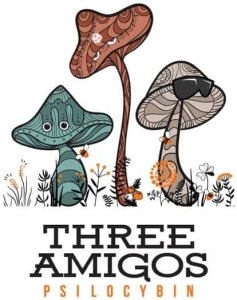Understanding Magic Mushroom Tolerance and Key Factors
Magic mushrooms are not just an avenue to explore the depths of consciousness – they’re also a natural product that requires some mindfulness in how you use them.
One key aspect that often goes overlooked is magic mushroom tolerance.
Whether you’re a seasoned psychonaut or new to the scene, understanding how tolerance to magic mushrooms works is essential for a fulfilling and responsible experience.
In this article, we’ll dive into what magic mushroom tolerance is, how it differs from dependence, and why taking breaks is not just beneficial but necessary. We’ll answer questions like “can you build a tolerance to shrooms”, how long does shroom tolerance last, and more.
Can you build a tolerance to magic mushrooms?
Let’s start from the basics.
Can you build a tolerance to mushrooms if they contain psilocybin in the first place?
The short answer is yes, you can build a tolerance to magic mushrooms.
Just like with many other substances that affect the brain, repeated use of psychedelic mushrooms can lead to a decrease in their effects over time. This happens because of the way your brain’s receptors interact with psilocybin, the active compound in magic mushrooms.
How does shroom tolerance work?
In order to understand how magic mushroom tolerance works, it’s key to take a scientific approach.
Magic mushrooms contain a psychoactive compound called psilocybin, which is responsible for their mind-altering effects. When you ingest magic mushrooms, your body converts psilocybin into psilocin, a compound that closely resembles the neurotransmitter serotonin.
Psilocin primarily interacts with serotonin receptors in the brain, especially the 5-HT2A receptor. This receptor is crucial in modulating mood, perception, and cognition – key aspects of the psychedelic experience. When psilocin binds to these receptors, it leads to the intense sensory and cognitive changes associated with a shroom trip.
However, the brain is incredibly adaptive.
When psilocin repeatedly activates the 5-HT2A receptors over a short period, your brain begins to downregulate or decrease the sensitivity and number of these receptors.
This process is a natural protective mechanism to maintain equilibrium within the brain’s chemical environment.
The result?
The same dose of magic mushrooms will have less effect than it did before.
This means that if you take magic mushrooms too frequently, you may find that the same dose produces weaker effects.
The more often you use them, the less sensitive your brain becomes to the experience, requiring higher doses to achieve the same level of effects.
This phenomenon is what is known as shroom tolerance.
Tolerance development timeline
Magic mushroom tolerance develops in a different way for each individual.
However, here’s an example of a frequently seen shroom tolerance development timeline:
- Initial use – After the first dose of magic mushrooms, your brain experiences the full impact of psilocin binding to the 5-HT2A receptors.
- Immediate aftermath – Within 24 hours of the experience, your brain starts to downregulate its serotonin receptors, leading to a noticeable increase in tolerance if you were to take another dose.
- Peak tolerance – Tolerance can build up rapidly, even after just one or two uses in quick succession. If you were to take magic mushrooms several days in a row, you would likely experience a significant reduction in the intensity of your trip. In some cases, users may find that the same dose has little to no effect if taken within a short period.
- Tolerance reset – Fortunately, magic mushroom tolerance also diminishes relatively quickly. After stopping use, the serotonin receptors begin to return to their normal levels. Typically, this process takes about 7 to 14 days, although some individuals may need longer for their tolerance to fully reset.
When consuming magic mushrooms, try to monitor the effects of the shrooms after each intake to get an idea of where you are in this timeline.
Tolerance vs. dependence: What’s the difference?
It’s crucial to differentiate between tolerance and dependence when discussing magic mushrooms.
Tolerance, as mentioned, refers to the reduced effects experienced over time with repeated use.
Dependence, on the other hand, involves a physical or psychological need to continually take a substance to avoid withdrawal symptoms.
Magic mushrooms are generally considered non-addictive, meaning that while you can build a tolerance, you’re unlikely to develop a dependence. However, taking shrooms too frequently can lead to diminished returns, both in terms of the experience and in your overall relationship with the substance.
How to calculate magic mushroom tolerance
Calculating your shroom tolerance isn’t as straightforward as punching numbers into a formula, but you can use certain guidelines to estimate how much your tolerance has increased and when it’s best to take your next dose.
Step 1: Understand your starting point
Your first step is to understand that tolerance builds rapidly with repeated use of magic mushrooms.
After just one experience, your tolerance could double within 24 hours, meaning you’d need twice the amount of mushrooms to achieve the same effects if you took them again the next day.
For most people, it takes about 7 to 14 days for tolerance to return to baseline levels after taking shrooms.
Step 2: Use a shroom tolerance calculator
A shroom tolerance calculator can be a useful tool to estimate how much your tolerance might have increased based on the time elapsed since your last trip.
While these calculators are not precise, they can give you a rough idea of how much more you might need to take if you decide to trip before your tolerance has fully reset.
Here’s a basic approach:
- Input the time since your last dose – The calculator will typically ask for the number of days since your last magic mushroom experience.
- Input your previous dose – Enter the amount of magic mushrooms (in grams) you took during your last trip.
- Calculate your current dose – Based on the time since your last dose, the calculator will suggest how much more you might need to take to achieve a similar effect. The longer the gap between trips, the closer your dose will be to your original amount.
Step 3: Adjust accordingly
If your shroom tolerance calculator suggests a significantly higher dose than you’re comfortable with, it’s a good sign that you might need more time to allow your tolerance to reset.
Remember, patience pays off.
Waiting a few extra days or even weeks can result in a much more rewarding experience than rushing into another trip with diminished effects.
Step 4: Monitor your reactions
Every individual’s body chemistry is different, and these calculators provide estimates based on general trends. It’s crucial to monitor your own reactions and adjust your dosage accordingly.
If you notice that you’re not getting the effects you desire, even with a higher dose, it might be time to take a longer break.
Practical tips for managing shroom tolerance
The good news is that you can manage your magic mushroom tolerance as long as you are well-informed.
Here are a few useful suggestions on how you can achieve this:
- Take regular breaks – As a general rule, it’s recommended to wait at least two weeks between trips to allow your tolerance to reset.
- Start low and go slow – Especially if you’re using a tolerance calculator, it’s wise to start with a lower dose and see how you feel before increasing it.
- Document your experiences – Keep a journal of your doses, the time between trips, and the effects you experienced. This can help you fine-tune your future doses and better understand how your body builds and loses tolerance.
How long does shroom tolerance last?
If you want to plan your psychedelic experiences wisely, it’s key to understand how long shroom tolerance lasts.
Typically, tolerance to magic mushrooms builds up quickly and can also diminish relatively fast.
As noted above, on average, it takes about 7 to 14 days for your brain’s receptors to reset and for your tolerance to return to baseline.
If you’ve been using magic mushrooms regularly, taking a break of at least two weeks is recommended to fully reset your tolerance.
This is not only for your brain’s benefit but also to ensure that your next experience is as profound and meaningful as you want it to be.
Why it’s important to take a break
Taking regular breaks between your magic mushroom experiences is more than just a practical measure. It’s a way to maintain respect for the substance and the journey it offers.
Continuous use without breaks can lead to diminished effects, which might push some users to increase their dosage unnecessarily. This not only heightens the risk of an uncomfortable experience but can also lead to a lack of appreciation for the nuances that magic mushrooms have to offer.
By giving yourself time to integrate each experience fully, you’re not just resetting your tolerance but also deepening your relationship with the shrooms.
This mindful approach ensures that each trip remains as impactful and enlightening as possible.
Tools to help manage your magic mushroom tolerance
For those looking to fine-tune their shroom usage, a shroom tolerance calculator can be a handy tool.
These calculators can help you estimate how much time you should wait between doses to achieve the desired effects.
While it’s not an exact science, using a calculator can give you a better idea of how your tolerance may impact your next experience.
Final thoughts
Overall, magic mushrooms offer a unique and powerful way to explore consciousness, but like any profound tool, they require respect and understanding.
By being aware of how magic mushroom tolerance works, you can make informed decisions that enhance your experiences rather than diminish them. Remember, taking breaks isn’t about restricting your journey – it’s about making each step along the way more meaningful.
At 3 Amigos, we believe in the transformative potential of magic mushrooms when used responsibly. So take your time, plan your experiences, and keep the magic alive by understanding and managing your tolerance.
James Sullivan is a writer for Three Amigos, specializing in natural remedies and mental health. An advocate for the therapeutic use of psilocybin, he combines his passion for writing with his love for the great outdoors.




